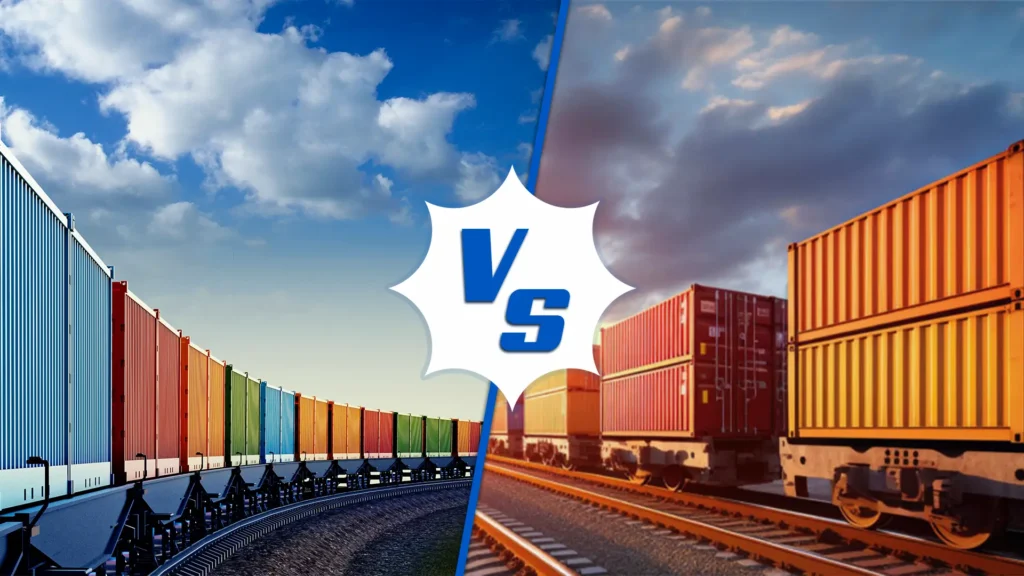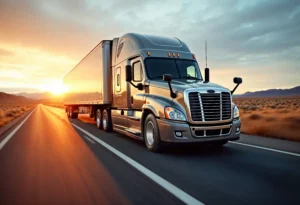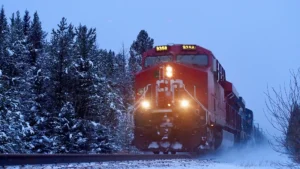Trains rule the rails, hauling mountains of stuff across the continent. But not all trains work the same way. There are two main players in this game, so let’s take a look at the key difference between an intermodal train and a freight train.
Understanding the difference between these two is crucial for grasping the complexities of the modern supply chain. But before that, let’s take a short glimpse at them.
What Is Intermodal?
Intermodal transportation offers a streamlined approach to moving goods. It utilizes standardized containers that seamlessly transition between various modes of transport, including rail, air, and maritime vessels. These robust steel containers eliminate the need for direct cargo handling during transfers, minimizing the risk of damage and expediting the overall shipping process.
How Does an Intermodal Train Work?
Intermodal rail transportation starts at special terminals assigned by intermodal rail companies.
Where intermodal trucks and other vehicles deliver cargo-filled containers. They are known as intermodal facilities. These terminals handle all sorts of containers, from the regular kind to ones that are temp controlled.
These facilities are placed in strategic locations to move goods quickly and easily. Their locations often include major seaports, highways with lots of truck traffic, and border crossings. And to avoid slowdowns, they’re typically built in areas with less congestion.
Advantage And Disadvantage Of Intermodal Rail
Intermodal transport for your cargo can be a great way to reduce shipping costs, especially for long trips. Trains can haul a ton of stuff in one go, way more than trucks! They arrive on time and avoid traffic jams, so your shipment arrives faster.
The Advantages of Intermodal trains –
- Cheaper for long hauls:
Trains are like big cargo trucks but way cheaper, especially for long distances.
- Holds Tons Of Stuff:
A single train car can carry way more than a truck, making them perfect for big shipments of things like cement, wheat, or coal.
- Less Traffic, Smoother Ride:
Trains don’t get stuck in traffic jams like trucks, so your shipment might even arrive faster. They also help by taking trucks off the road, reducing traffic jams for everyone.
- Eco-friendly:
Trains are way more fuel-efficient than trucks, which means they pollute less and are better for the environment. Intermodal Sustainability has been a positive talk in the industry for quite some time now.
The Disadvantages Of Intermodal Trains –
- Not for everything:
Trains can carry a lot, but some things like fresh food might need special care that trains can’t always provide.
- Needs Good Tracks:
Trains need good quality tracks to run smoothly, which might not be available everywhere, especially in remote areas.
- More Steps Involved:
Sometimes, your cargo might need to be loaded and unloaded from trains a couple of times before it reaches its destination. This can take some extra time.
- Security Concerns:
The longer your cargo is on the move, the higher the chance of something happening to it. Make sure it’s well secured!
What Is a Freight Train?
Bulk commodities are transported over great distances via rail freight, which makes use of specialized railway networks. Construction materials and forest products are frequently transported by freight train.
Rail freight has speed benefits over ground and sea freight, but its mobility is constrained by fixed infrastructure. For the final delivery, this might mean using complementary road freight, which requires moving the cargo to specific trailers at assigned rail ports.
How Does Freight Train Work?
Regular trains are like delivery trucks that pick up lots of different boxes going to many places. They stop at hubs (train yards) to unload some boxes and pick up new ones for other deliveries. This can be slower because of all the sorting.
Special trains, called unit trains, are like cargo trucks that only carry one type of good, like all TVs. They travel directly from the factory (where the TVs are made) to the store (where they need to be) without any stops to switch cargo. This makes them much faster since there’s no sorting involved.
Advantage And Disadvantage Of Freight Rail
Freight rails are a great way to move a lot of stuff around, especially over long distances, and they’re good for the environment.
The Advantages of Freight Rail –
- Super Green :
Trains use way less gas than trucks, which means less air pollution. In fact, they’re kind of like electric cars on tracks!
- Space Savers:
Trains can carry a whole bunch of stuff at once, making them super efficient, especially for big deliveries.
- Safer Rides:
Trains are much less likely to get into accidents than trucks, so your stuff is more likely to arrive safely.
- On Time Most of the Time:
Trains run on schedules, so you know exactly when your things will show up (usually!). No more getting stuck in traffic jams like trucks.
- Flexible Loading:
Trains can carry big containers or even separate wagons full of stuff, depending on your needs.
The Disadvantages of Freight Rail –
- Strict Schedules:
Train routes and times are set, so they can’t take special requests like trucks can.
- Not Door-to-Door:
Trains can’t pick up your stuff directly or deliver it to your doorstep. You’ll need trucks to help load and unload things, which adds to the cost.
- Better for Bulk:
Trains are expensive for small deliveries or short trips. They work best for big amounts of stuff going long distances.
- Limited Service in Remote Areas:
Trains might not go everywhere, especially in the countryside or mountains.
Common Problems For Both Intermodal And Freight Train
For long-distance, eco-friendly cargo movement, trains are the champion. They can handle massive loads and keep our planet healthy. But both rail methods have some major downsides to consider:
- Cost can be Higher, Especially Up Close:
Sometimes it can be more expensive to ship things by train than by truck, especially for shorter distances.
- Noise in the Neighborhood:
Trains can be noisy, especially for people who live near tracks.
- International Slowdowns:
Train tracks and rules can be different in different countries, which can cause delays when crossing borders.
- Track Traffic Jams:
There aren’t always enough train tracks to handle all the cargo we need to move, so sometimes trains have to wait.
Since we have talked about so many topics, it might get a bit confusing. So here’s a small recap
| Feature | Intermodal Trains | Freight trains |
| Cargo type | Intermodal containers only | Wide variety of goods (bulk materials, vehicles, etc.) |
| Design | Long trains with many containers | Can vary depending on cargo |
| Length | Typically longer (over 200 meters) | Variable Length |
| Purpose | Long-distance, efficient movement of large quantities | Versatile for various cargo types |
| Connection | Key part of global supply chains (seamless transfer between modes) | Not necessarily integrated with other modes |
| Containerization | Standardized containers for easy transfer | May or may not use containers |
| Supply Chain | Key component in global supply chains | Can be used in various parts of thesupply chain |
| Best use | Long-haul transportation, large quantities | Versatile for various cargotypes |
| Main Advantage | Seamless movement across different modes (ships, trucks, trains) | Adaptable to different cargoneeds |
Conclusion
So you have read our “difference between an intermodal train and a freight train” comparison. And now you must be asking which train reigns supreme?
The answer is – It all depends on your cargo!
For long journeys with standardized containers that need to seamlessly switch between transport modes, intermodal trains are the clear winner. Their focus on efficiency and large-scale containerized cargo makes them ideal for global supply chains.
However, if you have a wider variety of cargo types that don’t require containers, freight trains offer greater versatility. They adapt to your specific needs, whether it’s bulk materials, vehicles, or other unique items.
Ultimately, both intermodal and freight trains play crucial roles in the transportation industry. By understanding their strengths, you can choose the best option to move your goods efficiently and reliably.
Happy hauling!
FAQ’s
What Is The Difference Between Intermodal And Rail?
Intermodal is a specialized type of train used for carrying huge amounts of cargo. They each have two types of movement methods. Rail’s utilizing “carload” by boxcars and hoppers. While Intermodal using fast highway capable container trailers on special intermodal transports.
What Is The Difference Between Intermodal And Trucking?
The main difference is the vehicle. Trains (intermodal rail) use tracks for long hauls, while trucks can handle both short and long distances on roads.
What Are Three Advantages Of Intermodal Transportation?
In the current climate of depleting natural resources. Intermodal transportation has gained significant global traction due to its proven positive environmental impact. This method boasts reductions in harmful emissions such as CO2, fine particles, soot and nitrous oxide (N2O), alongside a decrease in diesel fuel consumption.
What Is The Most Common Intermodal Transportation?
Intermodal transportation refers to the movement of freight within standardized containers or trailers across two or more modes of transportation. These modes can combine air cargo planes, rail lines, trucks, and even maritime vessels.
While various combinations are possible, the most frequently used pairing involves rail and truck transportation.
What Does Drayage Mean In Trucking?
Within the supply chain, drayage denotes the short-distance movement of shipping containers by truck. This service often acts as a crucial intermediary step within a more extensive transportation process.
For instance, drayage might be employed to move a container from a docked ship directly to a specific warehouse.






